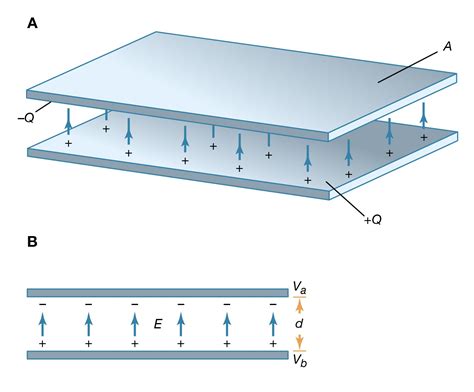Introduction
Capacitors are essential components in electronics devices, used for energy storage, filtering, and signal processing. Among the various types of capacitors, parallel plate capacitors are widely employed due to their simple construction and predictable behavior. An ideal parallel plate capacitor is a theoretical model that exhibits perfect capacitance and no energy losses. This article explores the characteristics, applications, and implications of an ideal parallel plate capacitor.

Characteristics of an Ideal Parallel Plate Capacitor
An ideal parallel plate capacitor consists of two parallel conducting plates separated by a dielectric material. The following characteristics define an ideal parallel plate capacitor:
- Infinite Surface Area: The plates have infinite surface area, ensuring uniform electric field distribution.
- Zero Plate Separation: The plates are perfectly parallel and have zero separation, maximizing capacitance.
- Perfect Dielectric: The dielectric material between the plates is non-conductive, lossless, and has infinite permittivity.
- No Energy Losses: There are no resistive, inductive, or capacitive losses within the capacitor.
These ideal conditions allow the capacitor to store charge efficiently and release it without any losses. However, real-world capacitors deviate from these ideal characteristics due to finite plate area, non-zero plate separation, dielectric imperfections, and energy dissipation.
Capacitance of an Ideal Parallel Plate Capacitor
The capacitance (C) of an ideal parallel plate capacitor is directly proportional to the surface area of the plates (A), dielectric permittivity (ε), and inversely proportional to the plate separation (d). The formula for capacitance is:
C = ε * A / d
where:
- C is capacitance in farads (F)
- ε is the dielectric permittivity in farads per meter (F/m)
- A is the area of the plates in square meters (m²)
- d is the plate separation in meters (m)
Applications of Ideal Parallel Plate Capacitors
Despite their theoretical nature, ideal parallel plate capacitors serve as a valuable reference model for understanding the behavior of real-world capacitors and designing electronic circuits. Applications include:
- Energy Storage: Ideal capacitors can store large amounts of charge without energy losses, making them ideal for applications such as power supplies and energy buffers.
- Filtering: Ideal capacitors can filter out unwanted frequencies in electronic signals, ensuring signal integrity and noise reduction.
- Resonators: Ideal capacitors, when combined with inductors, can form resonant circuits that amplify specific frequencies.
- High-Voltage Applications: Large-surface-area ideal capacitors can withstand high voltages due to the uniform electric field distribution.
Implications of Ideal Parallel Plate Capacitors
The concept of an ideal parallel plate capacitor provides valuable insights into the limits of capacitance and energy storage. It highlights the importance of maximizing surface area, minimizing plate separation, and utilizing high-permittivity dielectrics for practical capacitor designs.
Future Applications of Parallel Plate Capacitors
Recent advancements in materials science and nanotechnology have opened up new possibilities for parallel plate capacitors. Researchers are investigating the use of ultra-thin dielectric materials, graphene-based plates, and plasmonic effects to create novel capacitors with enhanced capacitance, energy density, and application potential.
Useful Tables
| Parameter | Ideal Value |
|---|---|
| Capacitance (C) | Infinite |
| Energy Storage (E) | Infinite |
| Energy Losses | None |
| Electric Field Distribution | Uniformly Distributed |
| Dielectric Material | Permittivity (ε) |
|---|---|
| Air | 8.85 x 10^-12 F/m |
| Paper | 3.5 x 10^-12 F/m |
| Ceramic | 10^-9 – 10^-8 F/m |
| Polymer | 10^-11 – 10^-9 F/m |
| Capacitance Range | Application |
|---|---|
| Picofarads (pF) | Tuning circuits, filters |
| Nanofarads (nF) | Bypass capacitors, signal coupling |
| Microfarads (µF) | Energy storage, filters |
| Millifarads (mF) | Power supplies, energy buffers |
| FAQs | Answer |
|---|---|
| Why is an ideal parallel plate capacitor not possible in reality? | Due to finite plate size, non-zero plate separation, and dielectric imperfections. |
| What is the advantage of a large surface area for a capacitor? | Increases capacitance and reduces electric field strength. |
| How does dielectric permittivity affect capacitance? | Higher permittivity increases capacitance. |
| What are some practical applications of parallel plate capacitors? | Energy storage, filtering, resonators, high-voltage applications. |
| What is the significance of an ideal parallel plate capacitor? | Provides a reference model for understanding real-world capacitors and designing electronic circuits. |
Conclusion
An ideal parallel plate capacitor is a theoretical model that provides a comprehensive understanding of capacitance and energy storage. Its infinite capacitance, zero energy losses, and uniform electric field distribution make it a powerful tool for analyzing and optimizing capacitor designs. While practical capacitors deviate from ideal conditions, the concept of an ideal parallel plate capacitor serves as a benchmark for striving for efficiency and performance in electronic devices.
